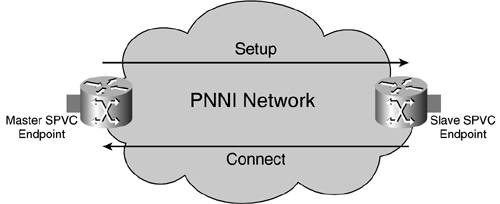Notes on SPVCs
| The original Cisco multiservice switching SPVC implementation follows the dual-endpoint SPVC model. In this model, an SPVC connection consists of two endpoints: an SPVC master endpoint and an SPVC slave endpoint. The following list details their functions:
This behavior is shown in Figure 10-16. Figure 10-16. Dual-Endpoint SPVC Model
In a dual-endpoint SPVC model, both endpoints must be provisioned with the same service category and traffic parameters for the slave endpoint to accept the call. The slave endpoint is persistent. This model is more robust than a single-endpoint SPVC model and has the following advantages:
Given these advantages, a dual-endpoint SPVC model is normally preferred. In the case of interworking between a multiservice switching platform and a platform supporting only the single-endpoint SPVC model, there are different options. The multiservice switching platform can be configured with a master SPVC endpoint, and no configuration is required in the other platform. The multiservice switching platform can also be configured with a slave SPVC endpoint. However, the other platform needs to be configured, and all service categories and traffic parameters need to match between both endpoints. You can use the formula shown in Equation 10-1 to translate traffic parameter values in different units. In particular, Table 10-6 summarizes the service category mappings to use when you configure SPVCs between a multiservice switching platform and a Cisco IOS Software-based platform.
Current PNNI software in multiservice switching platforms also supports single-endpoint SPVC model and nonpersistent SPVC slave endpoints. In this case, a PNNI node can be configured so that an SPVC or SPVP request can override existing SVCs and SVPs using the requested VPI/VCI. This is because an SVC can take a different VPI/VCI pair but an SPVC endpoint cannot. The command cnfsvcoverride is provided for that functionality; it defaults to no override. On the other end of the spectrum, pnports can be configured to block incoming SPVC requests for nonpersistent endpoints. This is achieved with the parameter -nonpersblock in the command cnfpnportcc, which configures the PnPort call control. Single-endpoint SPVCs can be released with the command clrspvcnonpers. Another new feature allows persistent slave endpoints in a dual-endpoint SPVC model to have a nodal traffic conformance tolerance factor for allowing SPVC request acceptance with different traffic parameters. This tolerance factor is configured as a percentage from the configured master endpoint's traffic parameters. The command cnftrftolerance lets you specify this nodal percentage, which defaults to 5 percent. |
EAN: 2147483647
Pages: 149
